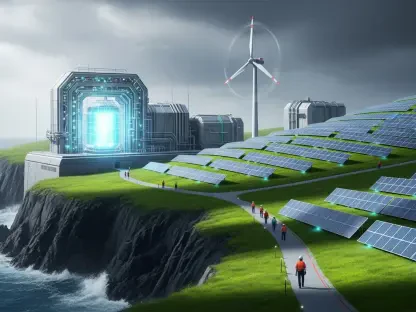What happens when a nation’s insatiable appetite for electricity collides with a tangle of federal policies and soaring costs, creating a perfect storm in the energy sector? The U.S. power market in 2025 stands at a pivotal moment, reshaped by the One Big Beautiful Bill Act (OBBBA), a piece of legislation that has sent shockwaves through developers, planners, and consumers alike. This transformative era, marked by unprecedented demand and policy upheaval, is redefining how energy is produced, priced, and planned. Dive into a landscape where innovation clashes with uncertainty, and the stakes for powering America’s future have never been higher.
The Stakes of a Power-Hungry Nation
The electric power system serves as the lifeblood of the U.S. economy, fueling everything from sprawling data centers to the hum of electric vehicles on highways. With demand surging at its fastest pace in decades, the pressure to build new capacity is immense. Yet, the OBBBA, coupled with stringent tariffs, has thrown a wrench into the economics of energy development, raising costs and clouding timelines. This isn’t merely a technical challenge; it’s a critical issue affecting businesses reliant on stable energy, households facing rising bills, and policymakers tasked with ensuring reliability. The outcome of this era will determine whether the nation can meet its energy needs without sacrificing affordability or sustainability.
Unpacking the Forces Driving Market Chaos
The OBBBA era is a complex web of competing dynamics, each pulling the power market in different directions. Electricity demand is climbing rapidly, with projections estimating annual growth of 1.1% to 2.2% through 2035, spurred by data centers, electric vehicle adoption, heat pumps, and a manufacturing revival. At the same time, federal policies are creating economic turbulence—shorter tax credit windows under the OBBBA and tariffs like Anti-Dumping and Countervailing Duties (AD/CVD) are driving up costs, with solar capital expenses potentially spiking by 30% to over 300%. These factors combine to form a volatile environment where even the most seasoned developers struggle to predict outcomes.
Beyond broad trends, market fragmentation adds another layer of complexity. Project costs for identical technologies, such as wind or solar, vary dramatically depending on how developers navigate policy risks—some rush to secure equipment before tariffs escalate, while others pause, unsure of future incentives. This inconsistency disrupts planning and investment, as even contracted projects face renegotiations due to unforeseen cost hikes. The result is a patchwork market where no two projects face the same economic reality, amplifying uncertainty across the sector.
Technology-specific impacts further illustrate the uneven playing field. Renewables like solar and wind bear the brunt of cost increases and policy hostility, with levelized costs for solar potentially rising by up to 470%. Meanwhile, natural gas plants are finding a foothold in high-demand scenarios, such as powering data centers that require constant energy. Battery storage, though less impacted by tax credit shifts, grapples with supply chain risks tied to imported components. This disparity shows a market caught between the push for clean energy and the pull of economic and policy barriers.
Ground-Level Perspectives on a Shifting Landscape
Voices from the industry paint a vivid picture of the challenges and adaptations unfolding in real time. Experts note that the U.S. power sector is experiencing load growth not seen in generations, yet policy volatility threatens to stall critical investments. Developers on the front lines describe a frenetic pace, with many scrambling to finalize deals before new tariffs or expiring incentives hit. A project manager overseeing a Midwest solar farm revealed, “Bids are being reworked in the middle of contracts—a rarity just a few years back—because the policy ground keeps shifting beneath us.” This candid insight underscores the urgency and unpredictability permeating every decision.
Beyond the rush to build, there’s a palpable sense of frustration among stakeholders. Some companies report projects being shelved indefinitely as cost projections spiral out of control, while others double down on riskier bets, hoping for a policy reversal. A utility planner in the Southeast shared that the focus has shifted from long-term strategy to short-term survival, with teams constantly revising forecasts to account for sudden legislative changes. These firsthand accounts reveal not just the scale of disruption but also the resilience required to navigate this turbulent period.
Strategies to Weather the Policy Storm
In an era where certainty is a luxury, adaptability has become the cornerstone of success for power market players. One key approach is embedding flexibility into resource planning by modeling diverse load and price scenarios to brace for abrupt shifts in demand or policy. This proactive stance allows utilities and developers to pivot quickly, whether facing a sudden spike in electricity needs or a new round of tariffs. Such scenario planning isn’t just a safeguard; it’s a competitive edge in a market where rigidity can spell disaster.
Another tactic gaining traction is crafting procurement contracts with built-in safeguards, such as reopener clauses or triggers linked to policy changes. These mechanisms ensure that agreements can be adjusted without locking in unsustainable costs, offering a buffer against the whims of federal action. Additionally, modular development—building surplus interconnection capacity or phasing projects to accommodate future tech or fuel switches—provides a way to future-proof investments. These strategies reflect a shift toward agility, prioritizing responsiveness over traditional long-term bets.
Speed, too, plays a critical role in staying ahead of the curve. Aligning with established developers who can fast-track timelines before incentives lapse is a practical move for many. This emphasis on rapid execution helps capitalize on fleeting windows of opportunity, especially as tax credits and other benefits face expiration risks. Together, these approaches form a blueprint for turning the chaos of the OBBBA era into a manageable, if challenging, path forward, tailored to the unique pressures of today’s energy landscape.
Reflecting on a Defining Moment in Energy History
Looking back, the OBBBA era stood as a crucible for the U.S. power market, testing the limits of innovation and endurance amid unprecedented demand and policy flux. The collision of soaring electricity needs with economic and legislative barriers reshaped how energy was planned and priced, leaving an indelible mark on the sector. From developers racing against tariff deadlines to utilities reimagining resource strategies, the period demanded a level of adaptability few had anticipated.
Moving forward, the lessons learned offered a clear directive: embrace flexibility as the bedrock of future planning. Stakeholders needed to prioritize dynamic contracts, modular designs, and rapid deployment to mitigate risks in an ever-shifting policy climate. Collaboration between industry and policymakers also emerged as essential, ensuring that future frameworks balanced growth with stability. This era, though fraught with challenges, paved the way for a more resilient energy system, provided the focus remained on strategic foresight and collective action.









